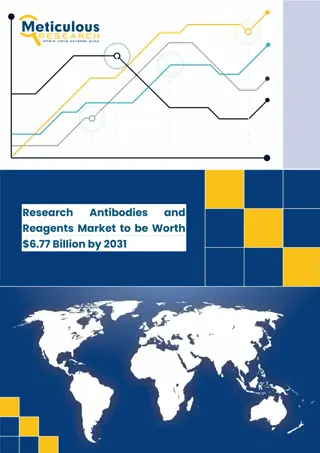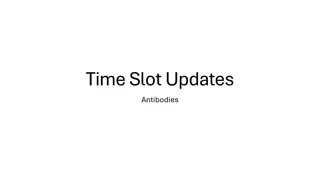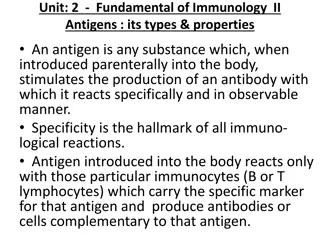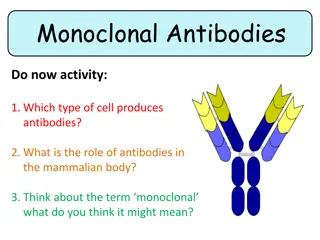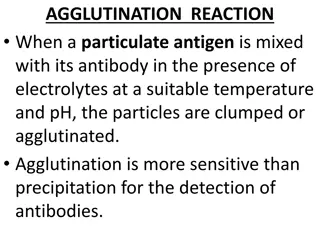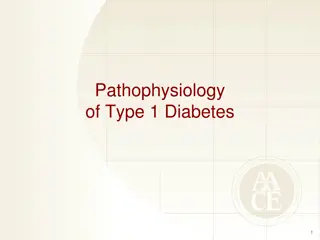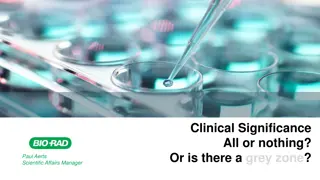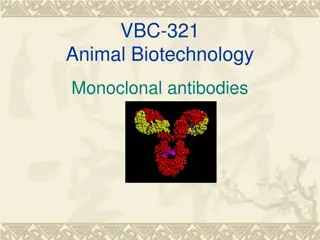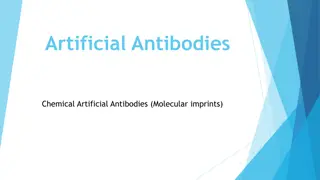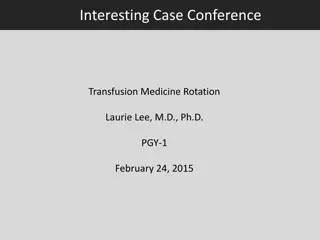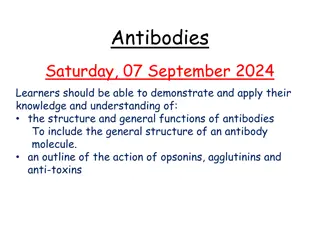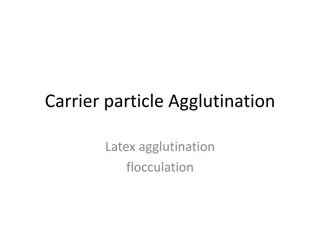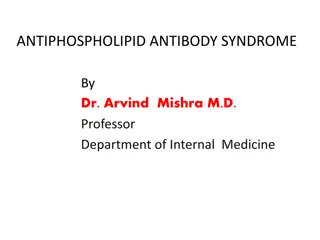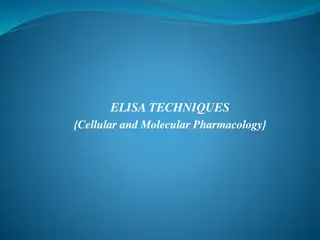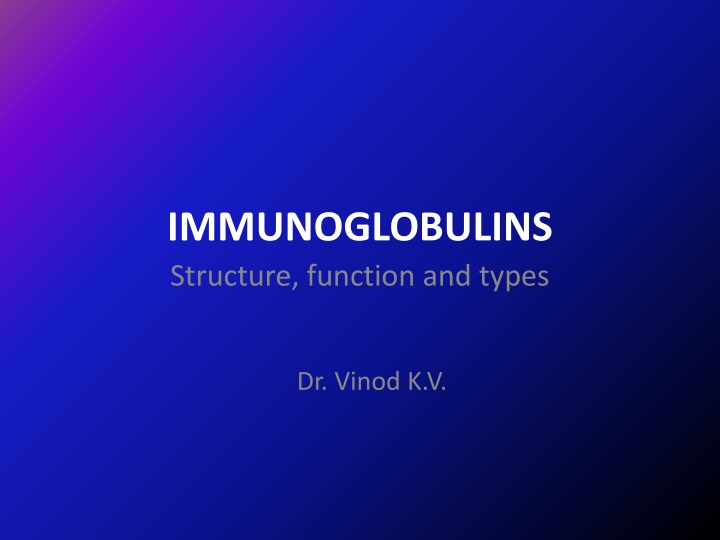
Immunoglobulins: Structure, Function, and Types Explained
Learn about immunoglobulins (antibodies): their structure, function, and different types produced by the body against antigens. Explore the detailed information on the two regions, variable and constant regions, and the significance of intra-chain disulfide bonds.
Download Presentation

Please find below an Image/Link to download the presentation.
The content on the website is provided AS IS for your information and personal use only. It may not be sold, licensed, or shared on other websites without obtaining consent from the author. If you encounter any issues during the download, it is possible that the publisher has removed the file from their server.
You are allowed to download the files provided on this website for personal or commercial use, subject to the condition that they are used lawfully. All files are the property of their respective owners.
The content on the website is provided AS IS for your information and personal use only. It may not be sold, licensed, or shared on other websites without obtaining consent from the author.
E N D
Presentation Transcript
IMMUNOGLOBULINS Structure, function and types Dr. Vinod K.V.
Also known as antibodies They are glycoproteins produced by the body against antigenic stimulus Synthesised by B lymphocytes
Basic structure Igs are glycoproteins Made up of two pairs of polypeptide chains One pair light chains- L chains (mw 25000 da) One pair heavy chains-H chains (50000 da) L & H chain and H & H chains are joined by disulphide bond 4 chains are joined to form a flexible Y shaped molecule
Two regions- Fab region & Fc region Fab region- at the tip of each arm of Y Fc region- limited in variability, responsible for the biological activity, act as receptor binding portion (to phagocytic cells), bind to complement Ag binding site @ amino terminus Ag binding site composed of both H & L chains
Both chains composed of two portions- variable region (N) & constant regions (C) Constant region constant sequence- One constant domain in L chain (CL) & 3-4 domains in H chain (CH1, CH2, CH3) Variable region one domain in both H & L chains- highly variable & determines immunological specificity Hyper variable regions (hot spots)- highly variable region in the variable regions
Intra chain S-S bonds form loops form globular domains VL & VH are responsible for Ag binding site Hinge region- between CH1 & CH2 , flexible and more exposed to enzymes & chemicals
L chains are of two types- Kappa & lambda (2:1 ratio in human sera) H chain 5 types- A, D, G, E & M
ANTIBODY STRUCTURE Antigen Variable region Constant region IMMUNITY IMMUNITY IMMUNITY Different variable regions bind different antigens. Identical constant regions induce identical responses.
Classes of immunoglobulins IgG heavy chain is gamma most common & major serum Ig (75-80%) Circulating Ig equally distributed in intra & extra vascular compartments Contains less CHO than other Igs mw 1,50, 000 da, half life 23 days 8-16 mg/100 ml serum concentration Exist as monomer Only Ab that can cross placenta & provide natural passive immunity Secondary response Ab- second exposure- production of Ig G is very rapid
provide long term resistance 4 sub classes- Ig G1-IgG4 Functions General purpose Ab, protective against agents in blood & tissues Enhance phagocytosis Participate in most immunological reactions neutralise toxins in blood & tissues Best for opsonisation Cross placenta
Ig A Second most abundant (10-13%) mw 4,00,000 da half life 6-8 days Major Ig in colostrum, tear & saliva Low in serum (0.6-4.2 mg/100ml) Two forms- monomer (in serum) & dimer (in secretions called secretory Ig A) Synthesised by plasma cells near mucosa Has a secretory piece produced by mucosa helps to cross mucos membrane & prevent from denaturation J chain connect monomers Sub classes- Ig A1 & Ig A2
Functions Secretory Ig A provide protection to respiratory & gastrointestinal tracts by inhibiting the attachment of the microbes to mucosa Causes degranulation of eosinophils & basophils Enhance phagocytosis by monocytes Activate alternate pathway weak in opsonisation
Ig M Third common Ig (5-8%) occurs as a pentamer (J chain)- largest Ig First Ig to appear in circulation- Primary response First Ab to be formed in fetus Deficiency is associated with septicemia Ig M is short lived, hence its presence indicate recent infection Four constant domains 500-1000 times more effective than Ig G in opsonisation, 100 times in bacterial action, 20 times in bacterial agglutination Neutralisation is less effective
Function Detection is useful in the diagnosis of syphilis, HIV, Dengue fever.. Good at complement fixation Causes lysis of microbes Effective in attaching to surface antigenic determinants Responsible for protection against blood invasion by microbes
Ig D Resembles Ig G in structure Monomer Mostly intravascular (3mg/100ml) Half life 3 days Occurs on the surface of unstimulated B cells Cell Bound Ig D are k type, serum Ig D are L type
Functions Helps in Ag recognition by B cells Binding of cell bound Ig D with Ag leads to stimulation of B cells, activation or cloning to produce Ab
Ig E Resembles Ig G structurally Monomer Found only in mammals mw 1,90,000 da half life 2 days Extravascular Ig Normal serum level in traces but elevated in allergic conditions Affinity to surface of mast cells-helps to produce histamines Mainly produced in the lining of respiratory & intestinal tracts
Function Provide protection by being hypersensitive Causes inflammatory response Special role in defence against helminth infection responsible for allergic reactions


